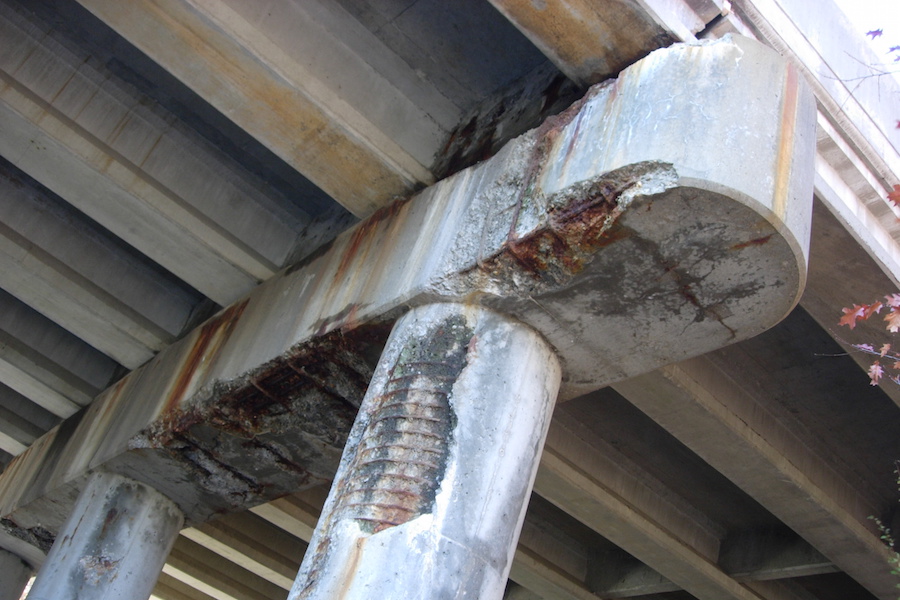The roads and bridges are crumbling, the airports are out-of-date, and there are many miles of railroad track lacking safety technology that might have prevented last week’s tragic derailment of an Amtrak commuter train outside of Philadelphia.
Business leaders, labor unions, governors, mayors, congressmen and presidents have all complained about a lack of funding for years, but aside from a one-time cash infusion from the stimulus program, nothing much has changed. There is still no consensus on how to solve the problem or where to get the massive amounts of money needed to fix it, just another example of political paralysis in Washington.
The sad part is that there is a broad consensus that something needs to be done and soon. But the most disabling myth, which has been repeated many times (and is a recurrent theme in the 60 Minutes program), is that the government can neither afford to spend the money competently, nor spend large sums of money fast enough, and will end up building bridges to nowhere. “Infrastructure spending”, then, is being used as a straw man to discourage adequate outlay, particularly by the GOP (which now controls both the House and Senate).
The issue takes on greater urgency in light of increasing evidence that the US economy is slowing down again. Even though it is about to enter its 7th year of recovery, the advanced estimates from the Bureau of Economic Analysis (BEA) suggest a tepid start to the year, with a first quarter GDP estimate of 0.2% growth. That paltry figure is likely to be revised downwards even further in light of America’s deteriorating trade deficit. Indeed, the current recovery is the weakest of the post-war period, and the prevailing fiscal conservatism (along with a strong dollar, which almost certainly will continue to affect adversely US exports), implies that for the US economy to continue to grow, private sector spending must exceed income, the same unhealthy combination that preceded the recessions of 2001 and 2008.
So infrastructure as an alternative to more private sector debt bingeing sounds like a no-brainer. The IMF has acknowledged that government spending has a higher economic multiplier effect than simple tax cuts. In addition, both the heads of the Chamber of Commerce and the AFL-CIO advocated the same in joint testimony to Congress recently.
If business and labor can come before you united on this issue — and we are united on this issue despite our sharp disagreements on a variety of other matters — I think that should tell everybody something and tell it very loudly
What’s the hold-up, then? It largely seems to come down to the question of affordability. In truth, the “affordability issue” is like one of the undead monsters in a horror flick, which returns predictably on cue to constrain rational policy goals. It is assumed that public debt (like private debt) is inherently unsustainable, even though such a conflation ignores the fact that the US government, unlike, say, a private corporation or household, is the issuer of the currency.
“No household can continually spend more than its income, and neither can the federal government” is the line one constantly hears. On the surface that might appear sensible; dig deeper and it makes no sense at all. A sovereign government bears no obvious resemblance to a household. Let us enumerate some relevant differences. First of all, the US federal government is almost 239 years old, if we date its birth to the adoption of the Constitution. No head of household lives that long. Even companies that go on for a long time have to resolve their debts when they expire.
Not so with the US government. It can roll over its debt indefinitely. It has the power to levy taxes and create currency (the Constitution grants this monopoly power to the government). It is also worth noting that with one brief exception, the federal government has been in debt every year since 1776. In January 1835, for the first and only time in U.S. history, the public debt was retired, and a budget surplus was maintained for the next two years in order to accumulate what Treasury Secretary Levi Woodbury called “a fund to meet future deficits.” In 1837 the economy collapsed into a deep depression that drove the budget into deficit, and the federal government has been in debt ever since. Since 1776 there have been exactly seven periods of substantial budget surpluses and significant reduction of the debt. From 1817 to 1821 the national debt fell by 29 percent; from 1823 to 1836 it was eliminated (Jackson’s efforts); from 1852 to 1857 it fell by 59 percent, from 1867 to 1873 by 27 percent, from 1880 to 1893 by more than 50 percent, and from 1920 to 1930 by about a third. Of course, the last time we ran a budget surplus was during the Clinton years, which, not uncoincidentally, was also a time when the country started with an unprecedented build-up of private sector debt (which, as the events of 2008 demonstrated, clearly is unsustainable). If Government budget deficits are truly “unsustainable”, and government must eventually pay back all that debt, it’s worth asking Congress why we have managed to avoid retiring debt since 1837-is 178 years long enough to establish a “sustainable” pattern?
Governments across the world have inflicted so many self-imposed constraints on public spending, that it has become really hard to see the truth behind public spending, despite the fact that it’s really simple and easy to understand. Naturally, we tend think that a balanced budget, be it for a household or a government is a good thing failing to make a distinction between a currency issuer and a currency user. To continue the discussion, it is necessary to make one crucial distinction, that between sovereign and non-sovereign countries (in the monetary sense). A country that pegs its currency exchange rate to another currency (or metal) doesn’t have monetary sovereignty as we define it; its domestic policy space is constrained by the necessity to maintain the peg. A sovereign currency is one that is not pegged; the government does not promise to exchange its currency to others at a fixed exchange rate. In that sense a sovereign currency is not convertible. The US, like many other developed and developing nations, has been operating on a sovereign monetary system ever since it went off the gold peg in 1973 (in contrast to nations of the Eurozone, which functionally borrow in a “foreign currency”, since the national governments no longer issue national currencies, but have ceded that responsibility to a supranational central bank).
The key insight is that if a government issues a currency that is not backed by any metal or pegged to another currency, then there is no reason why it should be constrained in its ability to “finance” its spending by issuing currency. If true, then a sovereign government doesn’t need tax and bond revenues to spend, as it can spend by issuing currency. In fact, modern sovereign governments actually spend by crediting bank accounts. Taxes result in debits of bank accounts; so budget deficits lead to net credits and budget surpluses lead to net debits. At the macroeconomic level, government spending increases private disposable income and taxes reduce it. A deficit then is the situation when the government is adding more to private disposable income than it’s taking away from it; it’s a net addition to private income. A government surplus has to equal the nongovernment sector’s deficit; government’s deficit equals the nongovernment surplus.
So there is little question that the government can “afford” to deficit spend on infrastructure, since it all entails are a few key strokes on a computer which brings the funds into existence. It is interesting that Congress seldom questions the idea about the “affordability” of a war. When it deems it necessary, the funds are simply appropriated and, presto, we have the dollars ready to bomb another country, or build several thousand more drones, tanks, etc.
And yet the “affordability” issue always arises when one is dealing with a social program such as Medicare, Social Security or a basic national need such as infrastructure. This, despite the fact that virtually everybody agrees that America’s national infrastructure is a mess and a large degree of public works expenditure should be focused on its renewal. On a daily basis, we drive on paved roads over bridges, take a hot shower, turn the lights on and off, and take out the trash. Most of us take these experiences for granted, expecting that our needs will be satisfied in a safe and convenient way. The universal availability of these services differentiates a modern country from a developing nation.
In fact, a public-works strategy for national recovery has had broad ideological respectability from the days of Alexander Hamilton and Abraham Lincoln to those of Franklin D. Roosevelt and John F. Kennedy. If Democrats can brag about the proud heritage of the Works Progress Administration and the Public Works Administration from the era of the Great Depression, there are still a few Republicans who remember the Golden Age of interstate highway construction that commenced in the 1950s with President Dwight D. Eisenhower. Indeed since the national shame of Hurricane Katrina, Americans have become outspokenly nostalgic about competent federal governments and magnificent public investments.
This infrastructure did not come into existence overnight. It took planning, effort, and a great deal of money. When the U.S. was still a colony of Britain, most of the country was untouched wilderness. A few years before the adoption of the Constitution, George Washington had plans to connect the Hudson River to Lake Erie, settle Ohio, and build steamboats. The Erie Canal for example, was not finished until 1825, 26 years after his death. It cost $7 million to build, a fortune at that time, but it cut the cost of shipping items from Buffalo to Manhattan by 90%. It paid for itself in ten years over in tolls collected, not to mention the development and trade it engendered.
Repeatedly through history we see that building infrastructure not only improves the standard of living through greater conveniences, but leads to increased general prosperity. The transcontinental railroad connected the railhead at Omaha, Nebraska to Sacramento, California in 1869. It cut travel time from the east coast to the Pacific from about five months to six days in an instant. Within a decade of completion, $50 million worth of goods had been shipped cross-country. Asian products reached the cities of the Northeast, Western settlers had access to Eastern finished goods, and the vast mineral resources of the heartland were available for exploitation. It was the internet of its day; it allowed ideas to travel quickly from one end of the U.S. to the other.
The transcontinental railroad was echoed later by the Interstate Highway System, which was initiated in 1956 and which is still not complete today. This led to the dominance of the automobile, and the exodus from the inner cities to the suburbs. Jobs and residences shifted outward. Massive economic development sprang up along the highway corridors. Railroads were largely abandoned for the now-cheaper roadways.
Unfortunately, the last few decades have seen very little investment in infrastructure in the U.S. In response, the American Society of Civil Engineers (ASCE) began grading the state of the nation’s infrastructure in 2001 to raise awareness of the silent crisis. As the 60 Minutes program discuss, the ASCE determined that every area from aviation to roads to wastewater needed serious attention. In ASCE’s latest report card, the society determined that the U.S. has made little progress, earning a collective “D.” To repair all the areas of infrastructure to good condition or a grade of “B” would cost $1.6 trillion over 5 years’ time. While that’s a big number, it represents about half what the U.S. has spent on the wars in Iraq and Afghanistan, the latter having virtually no multiplier effect in terms of aiding the US economy in creating good-paying jobs.
Fifty years ago, the U.S. spent a much higher percentage of its budget on infrastructure. But in the last 6 years or so, literally trillions of dollars are going to bail out banks, GSEs, insurance companies, and even the carmakers, as well as continuing to fund America’s extensive overseas military operations. To be sure, the last recession was particularly deep because the financial characteristics of some developed economies were such that the excessive size and low quality of private sector indebtedness promoted financial instability. A debt-deflation was set in motion in 2007 and required large government involvement to be stopped. While containment was successful, for millions of Americans, the usual “feel good” factor accompanying lower unemployment is still non-existent. The U.S. economy has performed especially poorly in terms of job growth even as economic growth has resumed, and private debt levels remain crushing. The current rate of job creation is not only insufficient to replace the jobs lost, crisis but can’t even keep up with labor force growth. At the recent pace of job creation, we only fall further behind. At the very least, a start on infrastructure would represent the beginnings of a rational strategy to put the US economy on a better track.





